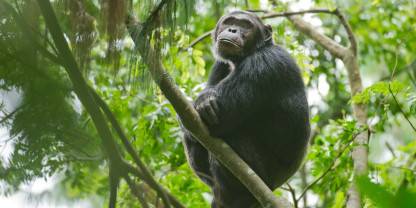Average Expert Rating
Rating Breakdown
Write a User ReviewA Primate’s Paradise
I went in search of Rwenzori colobus monkeys and my guide took me to a troop numbering about 600 individuals. Standing in the middle of the forest with these fluffballs all around me, I didn’t know where to look first. The main attraction in Nyungwe is chimp trekking. In the past, chimps were only semi-habituated, and the quality of sightings was variable. However, my last visit in 2022 was different as I felt these charismatic primates were
Read more
totally comfortable with our presence. I enjoyed watching a mother shielding her baby from heavy rain pelting down on us.The 160m-/525ft-long and 70m-/230ft-high Canopy Walkway is a must when visiting Nyungwe. Although I don’t have a fear of heights, I did enjoy the adrenaline rush when crossing this swaying bridge. However, once I got to the other side, I felt I needed more time to take it all in. I backtracked to fully appreciate the views and do some bird watching from this fantastic vantage point.
A fairytale forest
Nyungwe only became a national park in 2004, established to protect its lush rainforest that is home to a staggering 13 species of primates. These include huge troops of colobus monkeys that look like aging hippies with long white beards, plus grey-cheeked mangabey and chimpanzees. Chimps are also the main attraction in nearby Cyamudongo Forest and we were lucky enough to see several swinging in the trees and a young mum giving her baby a piggyback.
It really is like walking through a fairy tale here, with towering mahoganies and ebony trees, and it’s home to east Africa’s highest canopy walk where you teeter on a gently swaying bridge some 70m above the forest. Luckily, I don’t suffer from vertigo, but people who struggle with heights might find this unnerving! This is just one part of 130km of walking trails – you’ll have to take a guide, but they serve to enhance the whole experience and help to bring the secret life of the forest alive.
A Rainforest Haven Bar None
I first drove this road on a moto (motorbike) one misty night. It was cold, we didn't know where we would end up, and we spoke no local language. We got the public transport options so wrong that we ended up hitching. Luckily enough a member of park staff stopped to pick us up. It’s a remote part of the country.
On a subsequent – better organised – trip, I hiked the pretty waterfalls trail, one of many walks in Nyungwe. (It’s not a long walk but it’s steeper than the blurb suggests.) The Canopy Walkway alone is worth driving across the whole country for, but it’s not for the faint-hearted, hanging 70m above the forest floor. Stand in the middle and look from one horizon to another. There is not a single bit of evidence of human life.
Chimpanzees,
Read more
L’Hoest’s monkey and a habituated group of the Albertine Rift race (Ruwenzori) of the Angola colobus are a few of the primate highlights. Birds number 351 species, including 31 of the 37 known Albertine Rift endemics. A glimpse of the technicolor Ruwenzori turaco made my last trip complete.Rainforests and primates (a magical recipe)
The sounds of birds, frogs, insects, and apes offer up an orchestral treat for the ears, especially in the early morning when things are just starting to wake up.
I also love the atmosphere; the swirling mists and the humidity; the dark greens of a thousand species of plants, and the feeling that life abounds all around (even if most of it is hidden from sight behind the trees).
Nyungwe has swamps and bamboo forests, but it’s the jungles that will capture your heart and imagination. Here, you will have the opportunity to track and spend time with habituated chimpanzees, and you’ll also encounter numerous other primates including the charismatic colobus and the chubby-faced l’Hoest’s monkeys.
I’m not much of a birder, but I had an amazing time there on a dedicated guided bird walk and found dozens of different species, including the vociferous
Read more
great blue turaco (they sound like they are laughing at you).There are over 300 avian species that call Nyungwe home.
Superb Forest All-rounder
The main drawcard for most visitors to Nyungwe is the opportunity to track a habituated community of chimpanzees, the closest evolutionary relative to humans. Chimp trekking here used to be quite hit-and-miss, but the chimps are now very habituated and you are almost certain to see them. That said, the main trekking site is quite remote from any accommodation, which enforces a 5.30am start, and conditions underfoot are
Read more
very steep and muddy compared to most comparable destinations in Uganda and Tanzania.A dozen other monkey species are present in Nyungwe. The most conspicuous in my experience is l’Hoest’s monkey, a large and unusually terrestrial Albertine Rift endemic rendered unmistakable by its bold white ‘beard’. Also easy to locate is a very habituated troop of 500 to 600 Ruwenzori colobus that’s resident in the forest around the main campsite – this is thought to be the largest single troop of arboreal primates in Africa. Other praiseworthy features of this park are the magnificent setting, high standards of guiding, and an excellent 130km/80mi network of trails that includes the region’s only suspended canopy walkway.
Live like Tarzan
Despite being considered one of the most biodiverse forest parks in Africa, Nyungwe often plays second fiddle to Volcanoes National Park and its gorillas. Yet I prefer Nyungwe. There is a large variety of activities available – from forest canopy walkways to bird watching – and diverse forest wildlife that is often surprisingly easy to see. One of the best things about the park is the lack of other tourists. Don’t be surprised if there’s no more than a handful

